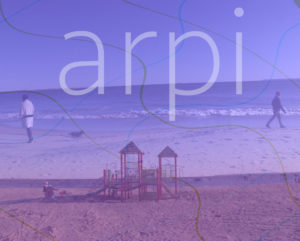
By Tara Aliya Kesavan
Project Description:
Arpi is an interactive installation that allows a user to play an audio-visual synthesizer by moving their bodies. The synthesizer generates an ambient soundscape coupled with undulating, generative patterns overlaying video footage of a beach. Short text prompts borrowed from Brian Eno’s work Oblique Strategies punctuate this environment with more direct opportunities for the viewer to slow down and reflect. The prompts ask questions and provide suggestions for those engaging in a creative process of any kind whether they are artists making work, teachers devising curriculums or chefs thinking up recipes! Given the escalating health crisis, Arpi aims to create a relaxing, playful and reflective experience.
Bio
Tara Aliya Kesavan is a multidisciplinary artist who blends film and photography with more tactile craft techniques to create unexpected results. She has combined lens based media with an array of crafts ranging from quilts to traditional printmaking technologies. This is her first foray into the world of interactive art.
I love the concept of this piece and am looking forward to playing with / experiencing a working model of it in action. It does have a soothing quality to it from the drone sounds to the rippling video lines mimicking the waves lapping on the beach and the wave generated lines in the sand. The slow reaction to movement forces the participant into a fluid movement interaction which has a calming flow that helps take the participant on a journey of sound, vision and movement. There are some things generative art works well for and this is one use it is well suited to. It also reminds me of the joy of creating sounds with synthesizers, the exploratory path you go down when finding out what happens when you plug this oscillator into this and see/hear what happens. I have spent many years playing with building physical and virtual synthesizers and this project brings me back to those moments.
Hi Tara I really really like the intersection of body movement and sound as our body movement is a language and a rhythm of our own life. Our body movement speaks so much about who we are and it is nice to see how we interact with our own bodies through sound. I also appreciate you showing the artists’ work that inspired you and how that relates to your personal story. This is an exhibition I would definitely love to experience in person. The slow motion beach scene also goes well with the sound waves and it is particularly refreshing to see it at this moment of self-quarantine. I wonder how you decided to choose the beach scene and if you would be open to others as well. I think abstract visuals could also work well with me as well especially the drone sound synthesized by the patch is free and ambiguous and it reminds me of light change as well. I wonder how it would look like if our body makes sound that creates light.
This project is a really impressive, especially since you say it’s your first foray into this. As someone who is interested in the area but finds it technically challenging I certainly appreciated the experimentation that you did in BEAP. Your introduction made me want to know more about the artists you mentioned and the role of pioneering women in the field of audio synthesis. I understand that the idea of the visuals and real time audio feedback was to produce a calming response but perhaps the parameters in that spectrum could have been more expansive to give the user a bit more feedback. (subjective of course). Would the parameters need to change depending on the physical space? In a large space could the parameters easily be changed so it’s about how a person’s entire body moves… or several people? Also, with your grandmother doing her doctoral thesis in acoustical physics, the personal component to this project is really nice to see. Bravo.